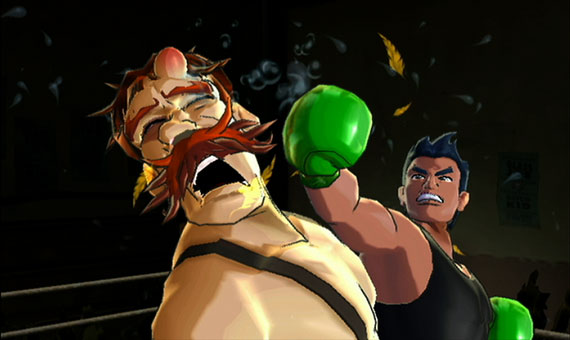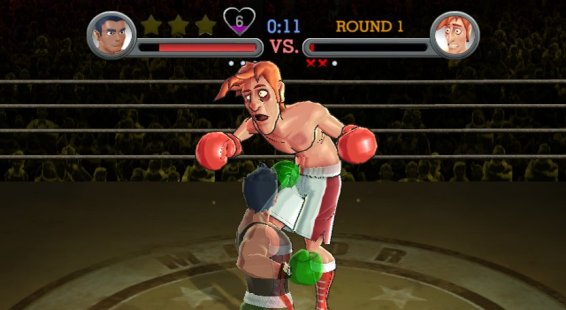Last updated on March 23, 2014
Punch-Out! is…well, Punch-Out! The story of the plucky underdog against the overly qualified (and humongous) champion continues to delight us all in popular culture. I dare say Punch-Out as a series came directly from the influence of Academy Award-winning film Rocky, who turned this simple tale into a part of our public consciousness. Video games do much the same, throwing overwhelming odds at the player only for them to rise above their circumstance and emerge triumphant.
So yes, it’s basically the book of Esther in video game form.
Obviously there’s no threat of horrible execution or massive killings (from either side, granted; see Esther 8-9 for that fun tidbit), but both fundamentally represent that similar human impulse to side with the downtrodden. Now, I’m not sure whether such an affiliation comes about as a natural side of us, or that we simply relate to that sort of story ourselves from cultural influences, but it’s definitely there. We did it then, we do it now.
Esther becomes Queen of the Persian Empire, even as a Jew without parents. Then she takes a risk to meet the King without being summoned, and somehow saves her people from Haman, who plotted to kill all the Jews from Mordecai’s gesture of disrespect. By being brave and refusing to play it safe (with some motivation from Mordecai – basically, damned if you do or damned if you don’t in Esther 4:13-4), she saves Israel’s exiles from further doom. And they created a pretty rad holiday to boot. Every Purim, Jewish people the world over retell the story of Esther, recognizing how God saved His people yet again from total extermination. They cheer for Mordecai, they boo at Haman, and everybody celebrates what God did and will continue to do for the broken, downtrodden underdogs. Pretty neat!
Consider that Esther’s age lies somewhere in the two millennium range, and you can imagine the longevity of this story archetype. When tropes work, they work, and you will always see them please and delight audiences in the same way. Add the video game and its promise of interactivity, and we heighten the same old story through mechanics. Punch-Out!, then, emerges as an exemplar of this archetype.
So with that convoluted and entirely pretentious introduction out of the way, how does Punch-Out!, the Wii remake/sequel/pseudo-sequel to Mike Tyson’s Punch-Out! and Super Punch-Out! fare, other than in their overuse of exclamation points for the purpose of emphasis? It plays the same. It plays almost identically the same.
Turn your Wiimote sideways, and behold its uncanny similarities to an NES controller; I honestly didn’t bother with motion controls or the Wii Balance Board, seeing that neither would actually add anything to the experience of cartoon boxing. Heck, the game plays nearly identical to previous entries in the series.
For the uninitiated: Little Mac, your character, stands facing his opponent in the middle of the screen. You punch using the 1 button to punch left, and the 2 button to punch right. The default punches will hit the opponent’s midsection, so hold up on the d-pad to smack their teeth out. You use the d-pad primarily to dodge punches from your opponents. Dodge left, dodge right, and dodge backward are all self-explanatory, as well as block (press up).
The goal of Punch-Out!, to knock your opponent out, is easier said than done. Each fight takes places within 3 rounds of 3 minutes each. You must knock out an opponent 3 times in one round, automatically garnering a TKO, or knock him down so many times that he can’t get up again. However, not a single one of the fighters (maybe except Glass Joe) will just let you walk up and punch them. Each fighter has their own style and specialty punches, noted by a series of audio, visual, and movement cues. Your job, as Mac, is to avoid these punches; since they are far stronger than you, failing to avoid dodges could prove fatal, as the same KO rules apply to you as well!
In basic, Punch-Out! forces pattern recognition and strict limitations on your abilities to elicit tension and difficult fights. The first few times, the opponent will totally destroy you, mostly due to either your lack of good reaction time or unfamiliarity. But, like any good game, you must repeat it over and over again until the pattern makes sense and you can successfully avoid each attack while counterattacking at the right time (usually after a blow or string of blows). Simply punching them (which they can and will block with ease) will reduce your Heart Meter, and if that empties you can’t even attack for at least five seconds – a long time in a game like this!
You’ve further incentive to punch back at the right times with the addition of the Star Gauge. Punch the opponent when then flash yellow for a split second, and you will earn a star; press A to use the Star Punch, which will remove 1/3 of an opponent’s stamina bar. Gather three stars, and it turns into an instant KO for the round. Of course, they balance this special ability by making you lose all your stars if you get hit, so you must dodge and weave successful through the wall of punches to earn a Star punch. A game rewarding good play? Gasp!
Other than that, the game looks wonderful, with a cel-shaded cartoon style that brings the lack of realism home to the player. Each fighter you encounter presents a unique, hilarious stereotype to fight, and I honestly found all of them a joy. Since later fights require you to think out of the box, even pre-empting their attack patterns, it really rewards experimentation to get the best times and the best methods. You’ll need to work against your naturally pattern-formation instinct, as knocking them to the ground will often change a foe’s patterns and introduce new attacks. Quite engaging, all said.
If anything, the factors working against the game is probably the controls and the strange difficulty curve. A wireless controller does not give you the same reaction speed as a wired one, regardless of how much leeway Punch-Out! provides. In that sense, the game is substantially easier than its predecessors, giving you a lot of time to dodge, duck, and block. I understand this decision from a purely practical standpoint, even if I think it subtracts from the overall experience.
If the original forced you to restart after losing all your continues, and Super Punch-Out! followed in its footsteps, Punch-Out! shoots itself in the foot by 1. providing a consequence free training mode for EVERY fighter and 2. allowing infinite continues. Losses add to a meaningless win/loss record, because who am I even being compared against? Part of Punch-Out!’s arcade roots meant a lack of safety; lose, and you might need to start over. Conserving your lives for Mike Tyson/Mr. Dream formed a part of the progression and necessity required for practice. Here, there’s no tension; practice away! Of course, beating the game unlocks the far-more-difficult Title Defense mode, but the same problem applies: practice, if for a longer time, to defeat each opponent. The game’s mechanical foundations haven’t been changed enough to integrate it well, unfortunately.
Since Punch-Out!’s a rather simple game, there’s really not much more to say. Learn how to dodge each punch at the correct timing, then punch the guy in his weak spot until he doubles over, leaving you the victor. The same formula, more or less, that worked two decades ago still works today. The same underdog story feels satisfying either then or now, and it’s no wonder the Punch-Out! formula survived after several decades to gaming audience new and old.
EDIT: I realized Last Stand Mode offers that “true” arcade experience, but the majority of the game lets you retry over and over again with zero consequence – most players will still never progress this far. My score and criticism stands.



